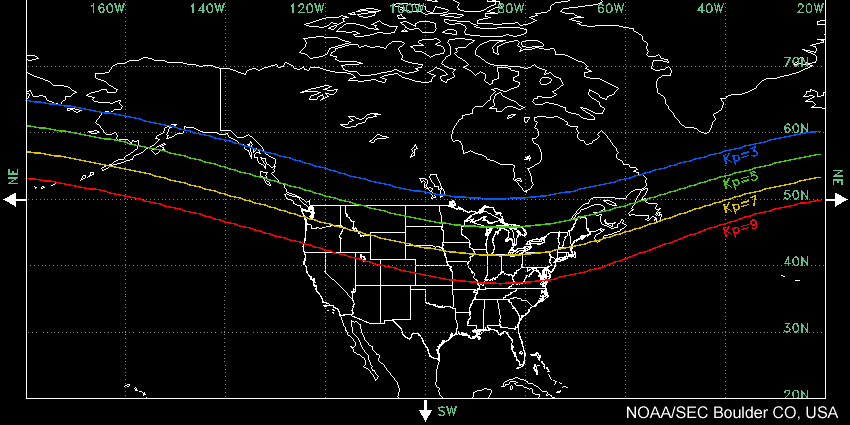Interactive Kp Explorer
The Kp-index is a 0-to-9 scale of geomagnetic activity. A higher number means a stronger aurora that is visible further south. Click any Kp value below to see what it means and how it affects visibility.
Potentially Visible From:
Geomagnetic Activity Scale
Aurora Visibility by Kp Level
These maps show how far south the aurora can be seen at different Kp levels in the US and Europe.
 United States
United States
 Europe
Europe
💡 Higher Kp values push the aurora viewing line further south
How Does It Work? The Simple Version
The sun constantly sends out a stream of charged particles called the solar wind. Earth is protected by its magnetic field, which normally deflects this wind.
However, when a strong gust of solar wind (from a solar flare, for example) hits Earth, it squeezes and rattles our magnetic field. All around the world, observatories called magnetometers measure how much the field is "wobbling."
The Kp-index is a clever global average of these measurements over a 3-hour period. This is why Kp forecasts are typically updated every three hours.
Finding the Best Viewing Spot
Get Away from City Lights
Light pollution is the aurora viewer's worst enemy. Drive at least 30-45 minutes away from urban areas to find truly dark skies.
Find a Clear View North
In the Northern Hemisphere, the aurora typically appears in the northern sky. Find a location with an unobstructed view of the northern horizon.
Check the Weather
Cloud cover will block your view completely. Use weather apps to find areas with clear skies, even if you need to drive a bit further.
Consider the Moon Phase
A bright full moon can wash out fainter aurora displays. New moon periods offer the darkest skies and best viewing conditions.
Timing Matters
The hours around local midnight are typically best. Be patient - aurora displays can be unpredictable, appearing and fading over several hours.
Kp-Index vs. G-Scale: What's the Difference?
Both scales measure geomagnetic activity, but they serve different purposes:
Kp-Index (0-9)
Measures planetary geomagnetic activity
- ✓ Best for predicting aurora visibility
- ✓ Tells you how far south the aurora might be visible
- ✓ Updated every 3 hours
- ✓ Scales from 0 (quiet) to 9 (extreme)
G-Scale (G1-G5)
Measures geomagnetic storm severity
- ✓ Focuses on potential impacts to infrastructure
- ✓ Used for warnings about power grid, satellites, GPS
- ✓ Scales from G1 (minor) to G5 (extreme)
- ✓ Generally, G1 ≈ Kp 5, G2 ≈ Kp 6, etc.
For aurora viewing: Focus on the Kp-index. For storm impacts: Watch the G-Scale.